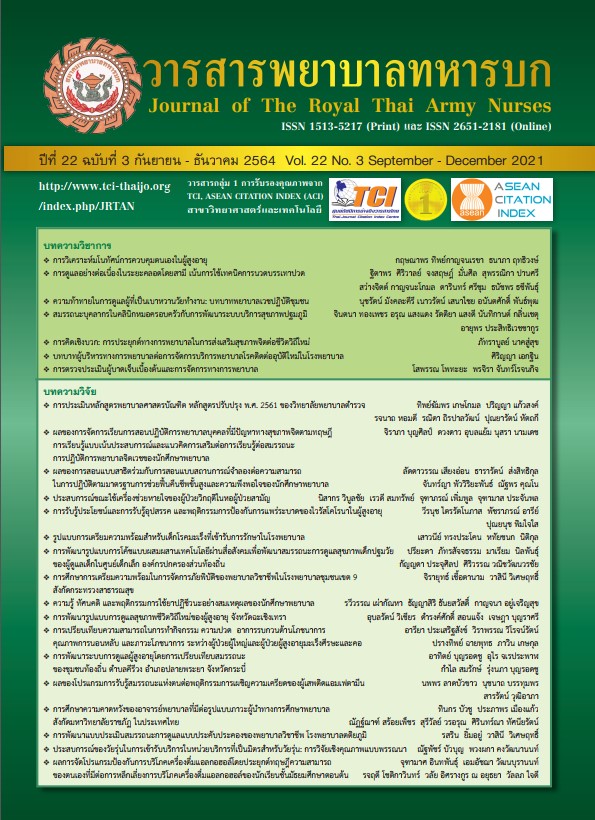Predicting Factors of Deliberated Self-Harm among Thai Adolescents
Keywords:
Adolescents, Deliberate Self-harm, Stress, Sex, School ConnectednessAbstract
This descriptive predictive research aimed to examine deliberate self-harm (DSH) and determine its predictors. A multi-stage random sampling was used to recruit the sample of 360 Thai adolescents aged 10-19 years who were studying in secondary schools in northern Thailand. The data were collected from July 2019 to January 2020. The research instruments were 7 self-report questionnaires. Their consistency reliability ranged from 0.81-0.89. Descriptive statistics, Pearson's correlation coefficients, and stepwise multiple regression were used for data analyses.
Results revealed that the participants had their DSH in the past six months about 3-14 times with a mean score of 6.11 (SD = 2.83). The best predicting factor was stress (ß = .271, p <.001), following by sex (male) (ß = .197, p <.001), student-school connectedness (ß = .193, p <.001), self-control (ß = -.187, p <.001), and resilience (ß = -.172, p <.01). These five significant predicting factors were together accounted for 18.80% (R2 = 0.188, Adj. R2 = 0.177, F5,354 = 16.422, p <.001) in the variance of DSH. These findings suggest that school nurses, teacher or related interdisciplinary personnel could be utilize as foundation knowledge to develop activities or programs to strengthen student-school connectedness, self-control and resilience, as well as diminish stress among Thai school adolescents to prevent DSH in male and female adolescents by more focused on male adolescents.
Downloads
References
Wu D, Rockett IRH, Yang T, Feng X, Jiang S, Yu L. Deliberate self-harm among Chinese medical students: A population-based study. Journal of Affective Disorders. 2016;202:137-44.
Morey Y, Mellon D, Dailami N, Verne J, Tapp A. Adolescent self-harm in the community: an update on prevalence using a self-report survey of adolescents aged 13-18 in England. Journal of Public Health. 2017;39(1):58-64.
Paholpak P, Rangseekajee P, Arunpongpaisal S, Piyavhatkul N, Thepsuthammarat K, Paholpak S. Characteristics and burden of hospitalization because of intentional self-harm: Thai national, hospital-based data for 2010. J Med Assoc Thai. 2012;156-162. (in Thai)
Nock MK, Cha CB. Psychological models of nonsuicidal self-injury. Washington, DC US: American Psychological Association;2009.
Baetens I, Claes L, Martin G, Onghena P, Grietens H, Van Leeuwen K, et al. Is nonsuicidal self-injury associated with parenting and family factors? The Journal of Early Adolescence. 2014;34(3):387-405.
Van der Wal W, George AA. Social supportoriented coping and resilience for selfharm protection among adolescents. Journal of Psychology in Africa. 2018;28(3):237-41.
Bennardi M, McMahon E, Corcoran P, Griffin E, Arensman E. Risk of repeated self-harm and associated factors in children, adolescents and young adults. BMC psychiatry. 2016;16(1):421.
Law B, Shek D. Self-harm and suicide attempts among young Chinese adolescents in Hong Kong: prevalence, correlates, and changes. Journal of Pediatric and Adolescent Gynecology. 2013;26(3):26-32.
Campbell KN. Resilience and Self-Control among Georgia Southern Students: A Comparative Study between ROTC Students and Non ROTC Students. 2014.
Rungsang B, Chaimongkol N, Deoisres W. Predictors of Suicidal Ideation among Thai Adolescents. Journal of The Royal Thai Army Nurses. 2017;18(1):64-73. (in Thai)
Hair J, Black W, Anderson R, Babin B. Multivariate Data Analysis (8, ilustra ed.). Cengage Learning EMEA. 2018.
Lundh L-G, Wångby-Lundh M, Paaske M, Ingesson S, Bjärehed J. Depressive Symptoms and Deliberate Self-Harm in a Community Sample of Adolescents: A Prospective Study. Depression Research & Treatment. 2011:1-11.
Viborg N, Wångby-Lundh M, Lundh L-G, Wallin U, Johnsson P. Disordered eating in a Swedish community sample of adolescent girls: subgroups, stability, and associations with body esteem, deliberate self-harm and other difficulties. Journal of Eating Disorders. 2018;6(1):5.
Lundh Lg, WÅngby-Lundh M, Bjärehed J. Deliberate self-harm and psychological problems in young adolescents: Evidence of a bidirectional relationship in girls. Scandinavian journal of psychology. 2011; 52(5):476-83.
Punwichai P. The Effects of Emotional Intelligence Practice Program on Enhancing Family Relations of Prathomsuksa Six Students Master’s thesis, Counseling psychology, Graduate study, Burapha University; 2005 (in Thai).
Spanjers KE. Development and Structural Analysis of the Student-School Connectedness Scale (SSCS), Thailand: Doctoral thesis of The Graduate School College of Education, The Pennsylvania State University; 2016.
Takviriyanun N. Development and testing of the Resilience Factors Scale for Thai adolescents. Nursing & health sciences. 2008 (in Thai); 10(3):203-8.
Saengthongdee P. Self-Control And Social Bond Factors Influencing Juvenile Drug Offending: A Case Study at Juvenile Training Centers in Bangkok, Thailand: Master’s thesis of Arts Program in Criminology and Criminal Justice, Mahidol University; 2007 (in Thai).
Wongpakaran T, Wongpakaran N. Confirmatory factor analysis of Rosenberg Self-Esteem Scale: A study of Thai student sample 2011 (in Thai). 59-70 p.
Beaton D, Bombardier C, Guillemin F, Ferraz M. Guidelines for the process of cross-cultural adaptation of self-report measures. 2016.
Jeensorn T, Apichartwiwat P, Jinsart W. PM10 and PM2.5 from haze smog and visibility effect in Chiang Mai Province Thailand. Applied Environmental Research. 2018; 40(3):1-10. (in Thai)
Downloads
Published
How to Cite
Issue
Section
License
บทความหรือข้อคิดเห็นใดใดที่ปรากฏในวารสารพยาบาลทหารบกเป็นวรรณกรรมของผู้เขียน ซึ่งบรรณาธิการหรือสมาคมพยาบาลทหารบก ไม่จำเป็นต้องเห็นด้วย
บทความที่ได้รับการตีพิมพ์เป็นลิขสิทธิ์ของวารสารพยาบาลทหารบก
The ideas and opinions expressed in the Journal of The Royal Thai Army Nurses are those of the authors and not necessarily those
of the editor or Royal Thai Army Nurses Association.






